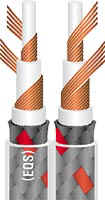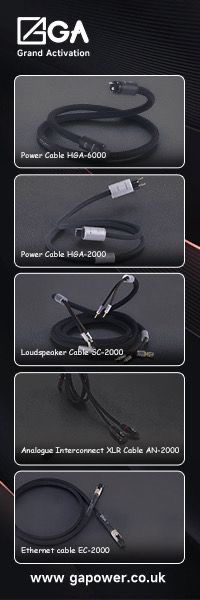WireWorld Equinox III Interconnects
| WireWorld Equinox III Interconnects |
| Frank Alles |
| 5 August 1999 |
 Specifications
Specifications
Interconnect
Outside to Inside:
Clear PVC
Black and Red Textile
Teflon Wrap
85 Polymer-Coated Grain-Optimized™ Copper Strands
Microporous Teflon ®
85 Polymer-Coated Grain-Optimized™ Copper Strands
Polypropylene Core
Retail price: $150 US / 1m pair, $80 US each additional meter.
Balanced version consists of two smaller coaxes for balanced connection with XLR plugs. Same price as the RCA version.
WireWorld
3320 Griffin Road
Ft. Lauderdale, FL 33312
Tel: 954/962-2650
Fax: 954/962-2603
E-mail: puresound@wireworldaudio.com
Web site: http://puresound@wireworldaudio.com
“In nature, an equinox doesn’t come along every day. There are only two days out of each year where the days and nights are of equal length the world over. The Equinox III cables attempt to strike this type of natural balance throughout the audible frequency spectrum….”
![]() Some cable designers voice their products to strike a particular tonal balance while others look to neutrality as their paradigm. Be that as it may, I haven’t come across very many cables that I’d consider to be “uncolored” in my 20-plus years as an audiophile. Certain cables accentuate the frequency extremes and are reticent in the mid-band, while others roll off the extreme bass and treble and offer lush midrange performance. Between these two examples are countless variations of individual character that are praised and sought after by high-enders.
Some cable designers voice their products to strike a particular tonal balance while others look to neutrality as their paradigm. Be that as it may, I haven’t come across very many cables that I’d consider to be “uncolored” in my 20-plus years as an audiophile. Certain cables accentuate the frequency extremes and are reticent in the mid-band, while others roll off the extreme bass and treble and offer lush midrange performance. Between these two examples are countless variations of individual character that are praised and sought after by high-enders.
But for a reviewer, neutrality in cable performance is necessary if we are to be trusted in our assessments of the components that they connect together. If we can eliminate cable colorations as a variable in our subjective evaluations then we are one step closer to uncovering the inherent personalities of the gear we review.
WireWorld’s president, David Salz, has always considered neutrality his yardstick in his own cable designs. Toward that end he has designed and implemented “The Cable Comparator System™,” a device that provides a very pure and direct connection for coupling–really docking–two components together, which acts as the control constant. Then a very high-quality switch is incorporated with corresponding inputs and outputs that allow for any set of cables to be compared to the direct connection. There are two different Cable Comparators, one for comparing interconnects and the other for use with speaker cables. Using the Comparators, one can in effect set up a double-blind bypass test to reveal non-linearities and other distortions in the cables under test.
These would appear to be a very valuable tools for designing neutral cables. With them, the designer can determine exactly where his prototypes deviate from that fine line of neutrality. I salute Mr. Salz for his ingenuity and for his personal quest of providing a line of high-quality cables that come close to this ideal.
Salz has done his homework and has experimented with different types of wire, dielectric materials, winding geometry’s, the outer insulation and the connectors. The result of his research is a patented concentric Symmetricoax™ design, that is claimed to distribute the electromagnetic field of the music signal evenly throughout the conductors for the lowest possible distortion. Salz further asserts that this is the only design that simultaneously minimizes resistance, inductance, capacitance, skin effect, mechanical instability, and external interference.
Enter Equinox III
“Throughout my extended evaluation of these cables one thing became clear to me the more I listened–THE MUSIC!”
In nature, an equinox doesn’t come along every day. There are only two days out of each year where the days and nights are of equal length the world over. The Equinox III cables attempt to strike this type of natural balance throughout the audible frequency spectrum exhibiting no deviations of any consequence.
Compared to many other high-end cables, the Equinox III, because of their flexibility and the narrow profile of the RCA plugs, were much easier to manipulate and bend into the places where I needed them to fit. At no time during my review period did these cables break, nor did they lift, rotate, or otherwise pull a light component off its feet. Hooray!
I have to confess that I’ve shamelessly taken advantage of David Salz’s hospitality by keeping my review cables for a much longer period of time than is customary. The good news for all you readers, is that this has allowed me to use these cables in two different systems and with a variety of components. Thus I am quite confident that my assessments are fair and representative of what you can expect.
The bulk of my listening was done with my InnerSound Eros speakers, powered by either a Sonogy Black Knight amp, or the Monarchy Audio SM-70 monoblocks. The Equinox III interconnects were installed between my AHT tube line stage and the active crossover of the Eros. Another set linked my Townshend Mk-III Rock turntable to an AHT/P phono preamp; and yet a third pair allowed me to connect the active crossover of a Paradigm Reference Servo-15 subwoofer to the system. My digital source consisted of the Parasound D/AC-2000 processor and C/DB-2000 belt-drive transport.
The same analog and digital sources fed my secondary reference system. From there, a pair of Equinox III cables connected an Adcom GFP-750 preamp to the Sonogy Black Knight amplifier, which drove Eminent Technology LFT-8a planar hybrid speakers.
The Sound
Throughout my extended evaluation of these cables one thing became clear to me the more I listened–THE MUSIC! Perhaps the nicest compliment I can give these wires was that I was not particularly aware of their presence in my system. Even when multiple pairs were used in tandem on successive components, the frequency balance seemed unaffected.
From the midrange through the highest audible frequencies these are among the most neutral and transparent audio cables that I’ve had the pleasure of using. The treble in particular was very pure, extended and detailed, without seeming at all exaggerated. Cymbals shimmered and sounded very convincing with a good sense of focus. Going to Rusted Root’s “baby will raam,” from Remember [Mercury 314 534 050-2] the shakers and the tambourine both sounded natural with good detailing and transient speed. The sprightly mandolin plucking was sweet and snappy without any hardness or overbite.
Though some cables, like Harmonic Technology’s Truth-Links, offered a bit more weight and oomph in the low bass, the Equinox III sounded more transparent and had better control. This was evinced on most tracks on Erykah Badu Live [Kedar UD-53109], which is rife with punchy drum work and the articulate electric bass of Hubert Eaves IV. Listening to track 9, “Certainly,” the electric bass was rendered bouncy, incisive and easy to follow, as opposed to the Truth-Link’s rendition, which was comparatively bloated and less distinct.
Also the Truth-Links seemed to tone down the upper midrange a bit, sapping a little immediacy and life from instruments like the trumpet. However, since there is no shortage of bright sounding digital gear, or for that matter bright recordings, some of you might prefer the HT’s, depending upon your associated gear and your own listening biases.
Though I hear a reticence in the Truth-Link’s upper midrange, they seem to have a mild emphasis in the lower treble, rolling off at the uppermost audible frequencies. To my ears the Equinox IIIs are more linear and extended throughout that portion of the frequency spectrum. Bells and triangles are not as forward sounding, but demonstrated plenty of nuance and air.
A comparison to WireWorld’s Polaris III interconnects proved to be an ear-opener as well. They had a punchier, more dynamic bottom end and with some recordings and exhibited a bit more soundstage dimensionality than their less costly siblings. Curiously there seemed to be a broad but mild rise from the upper-mids through the lower treble region. While this made for some impressive boom, snap and sizzle, it is my view that the music was better served with the unassuming Equinox IIIs on the majority of my recordings.
Conclusion
WireWorld has come up with a no-fuss, low-cost audio cable that will rival some big-buck models when it comes to overall transparency and tonal purity. Because of their flexibility and high-quality patented design they are as easy on the ears as they are to install and enjoy.
Honestly, I can’t think of any cable for the same money that can match this level of performance. However I can easily think of some expensive cables that are more colored and less capable of passing on the audio signal without alteration. This is especially true from the upper-midrange through the highest audible treble, where the performance of the Equinox III is simply stellar.
This is a cable that will let you hear what your components and recordings really sound like. Some of you will be happier with this knowledge than others, for the truth is often a double-edged sword. But if you’ve done your homework and have made wise decisions in putting together your system, then the Equinox III will let it shine–be it day–or be it night.
![]()
Don’t forget to bookmark us! (CTRL-SHFT-D)
Stereo Times Masthead
Publisher/Founder
Clement Perry
Editor
Dave Thomas
Senior Editors
Frank Alles, Mike Girardi, Russell Lichter, Terry London, Moreno Mitchell, Paul Szabady, Bill Wells, Mike Wright, and Stephen Yan,
Current Contributors
David Abramson, Tim Barrall, Dave Allison, Ron Cook, Lewis Dardick, John Hoffman, Dan Secula, Don Shaulis, Greg Simmons, Eric Teh, Greg Voth, Richard Willie, Ed Van Winkle, Rob Dockery, Richard Doron, and Daveed Turek
Site Management Clement Perry
Ad Designer: Martin Perry






Be the first to comment on: WireWorld Equinox III Interconnects